A dramatic sky over the southwest prairie at Nelson Lake preserve:
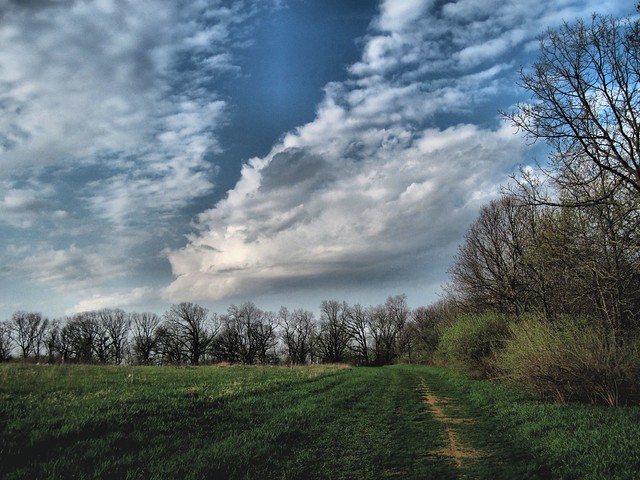
True, most sparrows are unobtrusive LBJ's (Little Brown Jobs). They can sometimes be difficult to identify or even find as they move around near the ground or perch on a distant shrub. Yet they are an interesting lot and, on closer inspection, quite varied and beautiful.
The most common sparrows of my childhood were called "Chippies" by my grandmother, who fed them bread scraps in the back yard we shared. Only after I found them pictured in my first bird book did I realize their proper name was English Sparrow, and that it was introduced from Europe. Later I learned that they were the only "true sparrows" I was ever likely to see in the US.
Renamed "House Sparrow," they populate most of the urban areas of North America including Mexico but not the high mountains or northern Canada. Although they are present in shopping centers less than a mile from our south Florida home, I have never seen one in our back yard or the wetlands near our home.This male is enjoying a meal in our daughter's feeder in Batavia:
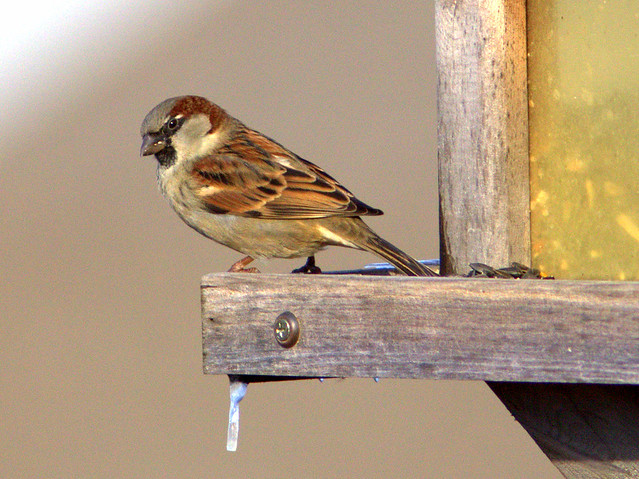
Closely related to weaver finches, the Old World "True" Sparrows (Family Passeridae) deserved naming rights before the LBJ's of the USA were ever discovered. I have yet to see a European Tree Sparrow, the other immigrant from this family, although it is quite common in St. Louis, Missouri and is also seen southwestern Illinois. The native sparrows in the Americas belong to a distinct family, Emberizidae, related to the Old World buntings.
Probably the best known representative of the American sparrow family is the Song Sparrow, which breeds all across the northern USA, up the Pacific Coast into southern Alaska and in much of the southern 2/3 of Canada. It migrates into all of the lower 48 States but does not reach southern Florida. It is appropriately named for its exhuberant melodic song (Nelson Lake, June 5, 2016) :

The Savannah Sparrow resembles it but is smaller, with a proportionately shorter tail. It may have yellow "eyebrows" which vary in intensity among its several subspecies:

During the winter, White-crowned Sparrows invade the lower half of the 48 States after breeding in northern Canada and the Rocky Mountains. They are large and quite handsome birds. This one was in our daughter's back yard:
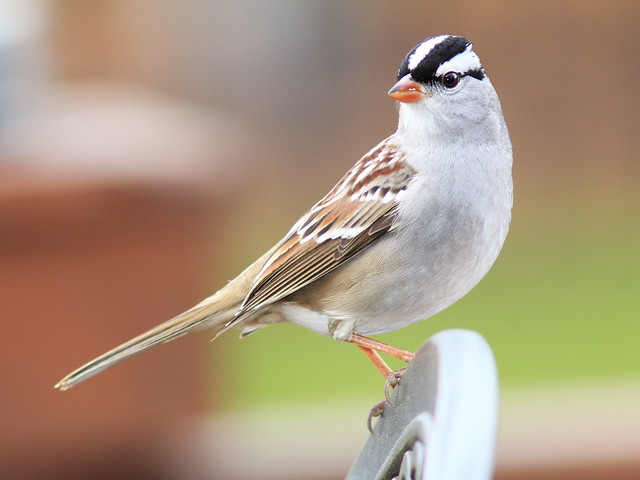
White-crowned Sparrow on our daughter's fence:
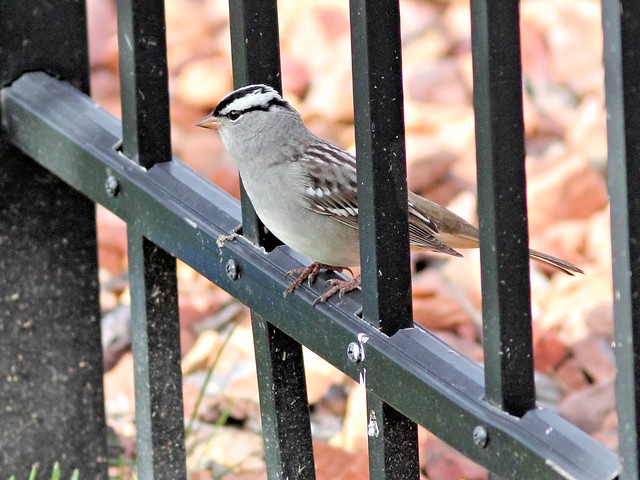
The immature White-crowned Sparrow has dull brown stripes on its crown before they are replaced by white:
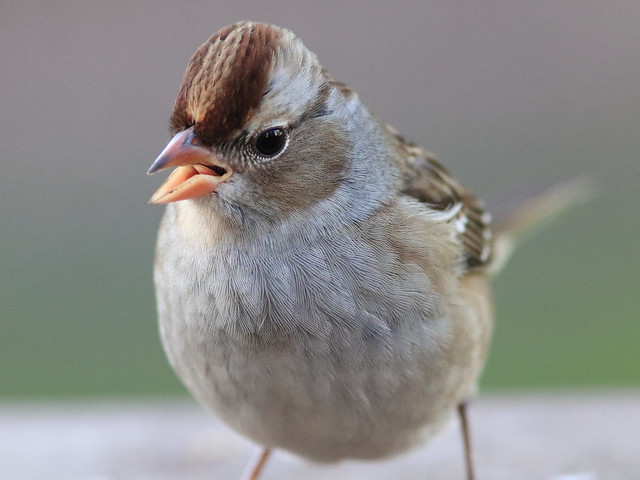
Somewhat similar but more compact is the White-throated Sparrow, another winter visitor to the lower forty-eight:
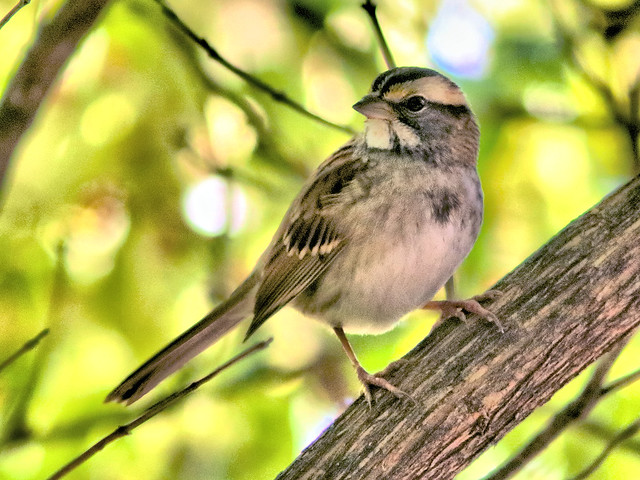
The Swamp Sparrow also has a white throat but its back is rufous and its head and breast are grayish. It breeds in wetlands of Canada and the north central and northeast portions of the US, migrating into the southeastern states and Mexico. We often see them in south Florida during winter:
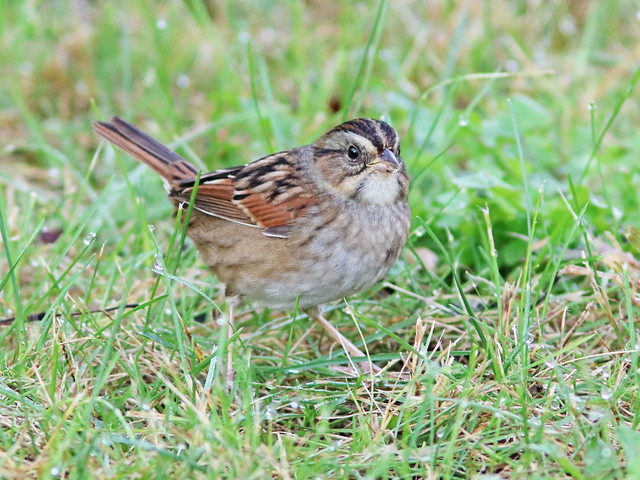
I could go on, but my archives include over 1600 photos of most of the 37-40 species of sparrows (and related towhees and juncos) which I have seen. Here is a scattering of favorite sightings.
Henslow's Sparrow is threatened by loss of habitat. It is a tiny reclusive and quite rare breeder at Nelson Lake:

Vesper Sparrow, known for its beautiful evening song. One sang on the roof of our Illinois condo until the entire surrounding area was developed:
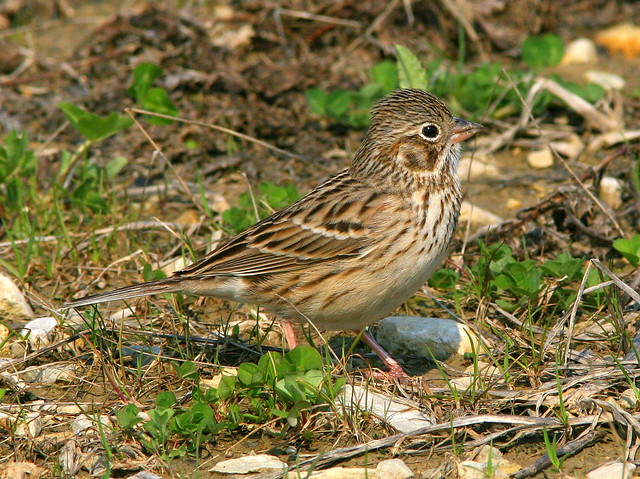
Field Sparrow, a persistent singer on the open prairie and wooded edges. Its pink bill and clear breast are distinctive:
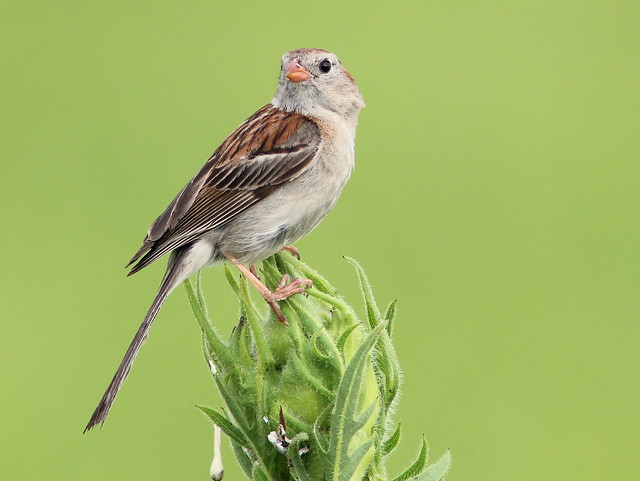
Fox Sparrow, quite a large sparrow, which breeds in the northwestern US and into northern Canada, is a common winter visitor to the woodlands of NE Illinois:
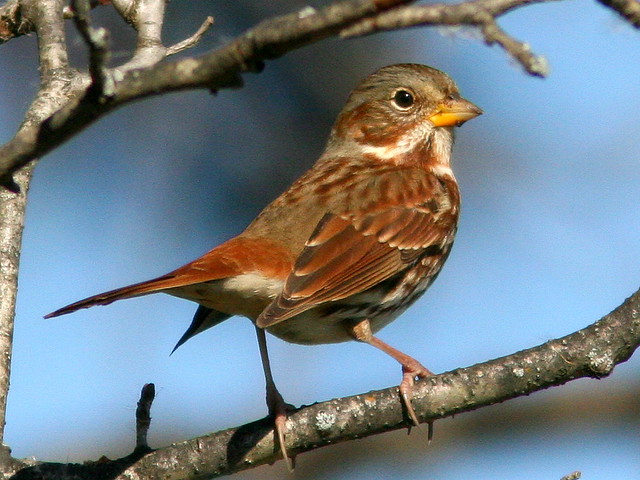
American Tree Sparrow, another visitor from the north, at our daughter's feeder:

Grasshopper Sparrow, fairly common breeder near our Illinois home, which even visited our south Florida neighborhood one winter (Illinois, July 24, 2017):

Grasshopper Sparrow (SE Florida, February 1, 2011):

Finally, a rare find in a vacant lot near our home were 2 or 3 pairs of Lark Sparrows, at least one of which raised a family. They persisted from mid-May through late July, 2017. There were very few historic records of them breeding in our county:

Lark Sparrow feeding fledgling (July 2, 2017):

When you read this I should be nearing the conclusion of several weeks of travel between Florida, Illinois, Wisconsin, the Texas Panhandle and the Gulf Coast off Corpus Christi, Texas. Therefore I prepared this post in advance. This has limited my computer face time and I have had to depend upon my iPhone. I will try to catch up upon my return home to Florida before going back to Illinois.
Here is a view of sunrise from our south Florida back patio to satisfy my urge to publish some nice reflections:

= = = = = = = = = = = = = = =
Linking to Misty's CAMERA CRITTERS,
Linking to Eileen's SATURDAY'S CRITTERS,
Linking to FENCES AROUND THE WORLD by Gosia
Linking to WEEKEND REFLECTIONS by James
Linking to BirdD'Pot by Anni
Linking to Wild Bird Wednesday by Stewart
Linking to Wordless Wednesday (on Tuesday) by NC Sue
Linking to ALL SEASONS by Jesh
I'm rarely interested in birds but I was truly interested in this article and admire your photographs. I doubt were easily taken. I had no idea there were sparrows other than 'sparrows' - though I would not, as the person you met seemed to, think any creature is 'only' an anything!
ReplyDeleteAs I say, I am not a bird person so maybe in England we have more kinds of sparrows than I am aware of. However, in my day-to-day life I come across house sparrows (which cheep on one note till you wish they would stop and which bounce around the place) and hedge sparrows (dunnocks) which are much shyer and hide in bushes and sing as beautifully as larks.
I love the colours and details in your photos, Kenneth, and the birds have lovely markings and patterns! Your last photo needs a frame!
ReplyDeleteOnly a sparrow, but so masterfully captured!! Love the opening and closing sky shots, too.
ReplyDeleteAwesome sparrow photos. I agree sparrows are interesting bird and can be hard to identify. We don't have any sparrows in the winter. In breeding season they can make themselves scarce.
ReplyDeleteAll of your photos are beautiful but the first and last were breath taking. Sunset in Florida - wow my back door view doesn't compare to that.
ReplyDeleteVery lovely little birds and beautiful sky.
ReplyDeleteWow! That is a lot of Sparrows!
ReplyDeleteThe two I see most often here in northeast MS and mid-south TN is the House Sparrow and the Chipping Sparrow. I have seen White-throated Sparrows a few times.
Your photos are excellent!
Great bunch of LBJ's!
ReplyDeleteLovely post! I like sparrows. They frequent our feeders in the winter and then raise families in our bird houses in the summer. I see them in the bird bath too.
ReplyDeleteVery nice photos, Kenneth. I love your photography!
ReplyDeleteBird shots are great. I love the Florida image best.
ReplyDeleteI love the sparrows and your photography shows their beauty and the awesome Florida sunrise ~ is exquisite ~ ^_^
ReplyDeleteHello, you have a wonderful collection of sparrows. Many of which I have not seen yet. Love the sky shots, the last one is gorgeous. Thank you for linking up and sharing your post. Happy Saturday, enjoy your weekend.
ReplyDeleteSo many varieties of sparrows. We get many of them visiting our garden.
ReplyDeleteI always learn so much from your posts. I guess none of us really think about how man different sparrows there are...we just lump them all together. I'm glad you've had a good trip. We are having some thunder here in North Central FL today...may get some rain soon. Enjoy your weekend!
ReplyDeleteOh My Word, I am so impressed for I know not much of anything at all about Sparrows and for me a Chip[pie would be a nickname for a Chipmunk, so I would not even have that one proper. Wonderful Sparrows shared but you have my favorite as your final entry, really gorgeous is the Lark Sparrow~
ReplyDeleteI had NO IDEA there were so many different types of sparrows! We had so many at our house in Tucson and I always loved to see them. I think they were House Sparrows. And I think that's what we have here, but I am unsure of myself. :-) Anyway, they are always welcome. I just wish I was better at identifying all the birds I see! Great post! Loved the photos!
ReplyDeleteBeautiful glow
ReplyDeleteSo many different sparrows - they really are attractive little birds. We have the song sparrow here in WA state and it truly is wonderful to hear. Amazing photos.
ReplyDeletewe have very few different species of sparrows here (2) but you have such a vaariety adn I remember when you did a wonderfu post on Sparrows ages ago explaining the differences in them All those photographs are splendid kenneth but that sunris in the last shot takes the rize this week. Have a good week ahead.
ReplyDeleteLOVED this post!!!! I learned something about the white crowned sparrow also; that the juvenile has a buffy crown BEFORE it turns all white. This was so very informative. My favorite in your series is the Fox Sparrow. How pretty. They may all be a 'common' bird, but to see them in one post makes it all the better! I thank you for this! And thanks for sharing with us birders this weekend at I'd Rather B Birdin'.
ReplyDeleteToo bad it was so hot and dry here while you visited. Glad to hear at least you had one of Port A's dolphin tours!! I thought of you and your family out searching for the white morph...maybe next time.
Very interesting article,backed up by some really good photos. The White-crowned sparrow is the only one i've managed to photograph, September 2015 San Francisco.
ReplyDeleteAll the best, Gordon.
Wow, you're doing a lot of traveling! Am amazed at the white crowned and white throated sparrow. These birds are a king/queen compared to the common "house" sparrow!
ReplyDeleteReally appreciate your comment about the ethnic groups. Wished some older and wiser people have some influence to cool down these hotheads nowadays! Hope you take a break from all that travel and relax a little:):)
I feel sorry for the guy that can't see the beauty in sparrows.
ReplyDelete